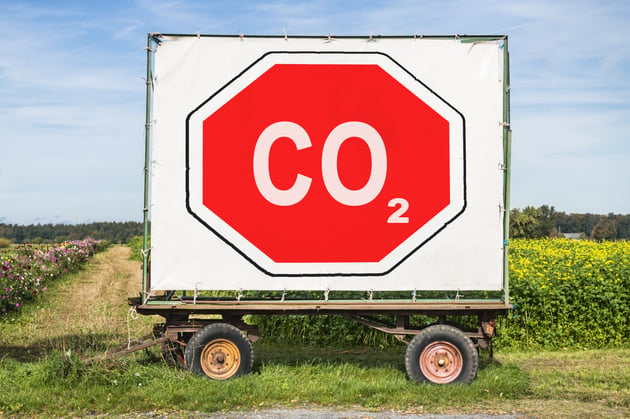In times of climate change and increasing environmental impact, it is essential for companies to address how they can reduce CO2 emissions.
In order to limit global warming and minimize the negative consequences, it is now more important than ever to take responsibility and actively contribute to the protection of our environment. As a responsible company, you face the challenge of reconciling economic success with environmental protection.
In this blog entry, we would like to present effective ways for your company to be able to reduce your CO2 emissions. From optimizing energy efficiency to using renewable energies and promoting environmentally friendly transport solutions. The following advice will not only strengthen your corporate image, but also save costs.
Saving CO2 in companies - the most important things
CO2 emissions are a major cause of climate change. This has many negative impacts on our environment, society and economy. Human activities such as the burning of fossil fuels (coal, oil or gas), industrial processes, transport and deforestation significantly increase CO2 emissions. There is evidence that the concentration of CO2 in the atmosphere has risen sharply in recent decades. Reducing CO2 emissions is therefore essential for businesses to counteract the negative effects of climate change.
Tips for saving CO2: for companies
In order to be able to reduce CO2 emissions, we have summarized some tips for you. Even small decisions make a contribution to being able to shape a future worth living for future generations.
- Optimise energy efficiency: The first step is to check your production processes, office buildings and other areas of your business for energy waste to reduce CO2 emissions.
- The switch to renewable energy: An effective way to drastically reduce your carbon footprint. Installing solar panels on the roof, using rainwater harvesting systems and insulating buildings are just a few examples of how companies can reduce their CO2 emissions. Using renewable energy not only helps protect the environment, but can also lead to cost savings in the long run.
- Sustainable Procurement: Pay attention to sustainability when procuring products and raw materials. Prefer suppliers that use environmentally friendly and CO2-neutral production processes.
- Sensitize employees: The participation of your employees is crucial to the success of your CO2 reduction measures. Make your workforce aware of the issue and motivate them to actively contribute to the sustainability trend. To reduce CO2 emissions, for example, promote the use of public transportation, carpooling, or cycling to work through leased company bicycles.
- Waste prevention and recycling: The recycling of materials and consistent waste avoidance also contribute to CO2 savings. Companies should analyze their waste streams and find ways to minimize waste and use resources more efficiently. However, reusable containers for food or drinks also help to sustainably reduce CO2 emissions and at the same time reduce waste production.

Reduce CO2 emissions during transport
A central factor for the CO2 emissions of companies is transport. Use modern logistics solutions to reduce CO2 emissions in freight transport as well and thus reduce your ecological footprint. Bundling deliveries, efficient route planning and using electric vehicles can achieve significant savings here.
Tips for a CO2-neutral transport
To reduce the CO2 emissions of your transports, you can opt for CO2-neutral transport options. For example, use environmentally friendly transport companies or invest in climate protection projects such as reforestation programmes or renewable energies to offset your CO2 emissions. Using biofuels as an alternative to conventional petrol or diesel can also reduce CO2 emissions. Biofuels are made from renewable raw materials and are therefore CO2-neutral because they bind CO2 during growth.
To reduce dependence on fossil fuels, use electric vehicles in your fleet. They do not produce harmful emissions during use and thus contribute to CO2-neutral transport.
And through improved route planning, companies can also reduce fuel consumption and thus cut CO2 emissions. Sustainable transport is also helped by the use of telematics technology, which enables efficient fleet management.

Make business travel CO2-neutral
A first step towards a more sustainable business trip is to decide on the means of transport. If possible, you should travel by train. For smaller distances, cycling or car sharing is a good option.
An environmentally friendly alternative to face-to-face meetings can be video conferencing. By using modern technologies, business meetings can be held online, which not only protects the environment but also saves time and money.
When choosing accommodation, it is also advisable to look for sustainable hotels or accommodation with environmental certificates. These rely more on renewable energies, environmentally friendly cleaning products and waste avoidance. This again ensures that your company can reduce CO2 emissions.
Tip: We have summarised how to plan your next company trip in a structured way in a business trip checklist.
Reducing CO2 emissions - for a shared, sustainable future
Reducing CO2 emissions is particularly important for companies to shape a sustainable future and mitigate climate change. By focusing on renewable energy, energy-efficient processes and sustainable procurement, companies can not only reduce their environmental impact, but also reap economic benefits in the long run. It is time for companies to take active measures and assume their responsibilities to reduce their CO2 emissions and contribute to a greener future.
Your business partners and customers will recognise your sustainability efforts and you can position yourself as a pioneer in environmental protection. At TROIKA, we too are already striving to create a more sustainable future.
Reducing CO2 emissions - working together for a sustainable future!



Comment